Volvo can’t sell safety anymore.
Well, it can’t sell just safety – because everyone else sells safety, too.
They have to.
Back in the ’60s and ’70s – when Volvo made its name as the “safe car brand” – other brands were less safe – in terms of crashworthiness – because they could be. There were only a few federal standards that new car manufacturers had to comply with; the rest was up to them – and most of them emphasized other things – such as styling or power or high fuel economy.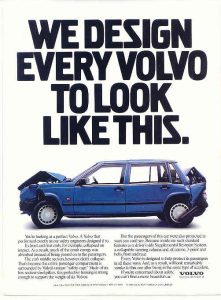
Today all cars are crashworthy because the law requires them to be.
Volvo is still a leader as far as designing cars to avoid crashes – and protecting passengers from impact forces if a crash is unavoidable – but the gap between Volvos and others is nothing like it once was.
So Volvo’s got to sell you on something else.
How about a turbocharger and a supercharger?
Volvo will sell you that, too – in the same vehicle.
That’s something no one else is is selling.
And it’s not the only thing Volvo’s selling.
The XC60 is Volvo’s medium-small crossover SUV – similar in size and general layout to others in the same class such as the BMW X3 and Audi Q5.
What makes it unusual, though, isn’t its shape or size but the range of engine options it offers.
These range from predictable – to radical – and at least plausibly economical.
Turbo four.
Turbo-hybrid four.
Also unusual is that these three engine configurations are available in any of the XC60’s three available trims. You don’t have to buy a higher trim to get the drivetrain you want and – conversely – you’re not forced to buy a drivetrain you don’t want to get the trim (and other features) you do want.
This runs contrary to the industry-standard practice of bundling a more powerful (or otherwise desirable) engine with the more expensive trims.
And it gives Volvo another thing other brands don’t offer buyers.
Prices start at $39,200 for the base T5 Momentum trim, which comes standard with a turbocharged 2.0 liter engine and front-wheel-drive.
AWD is available optionally.
From there, you can select R-Design and Inscription trims – and spec’d out with either the 2.0 turbocharged engine or a turbo-and-supercharged version of the 2.0 liter engine.
There’s also a plug-in hybrid version of the 2.0 turbo’d engine, paired with an electric motor and battery pack. It lists for $52,900 to start.
If you pick the turbo-supercharged engine, regardless of Momentum, R-Design or Inscription trim, your XC60 becomes a T6.
If you go with the plug-in hybrid drivetrain, it becomes a T8e.
It’s a lot of designations – and it can be a little confusing – but it’s worth sorting though it all because of all the choices Volvo gives you.
Which rivals don’t.
Major updates for 2019 include standard heated seats and windshield wipers in AWD-equipped models; R-Design and Inscription trims (T5 or T6) now come standard with a premium 600 watt, 14-speaker stereo system, park assist and power-folding rear headrests.
WHAT’S GOOD
So many choices – without few limitations.
More size-efficient than some smaller – and some larger – rivals.
Unusual for the class (and price range) features such as massaging seats and Level 2 semi-automated driving technology.
18-inch wheels and short-sidewall “sport” tires are standard; these sharpen up steering response but also roughen up the ride. They’re also noisier than 17-inch wheels with less aggressive tires.
Hybrid’s main draw isn’t really economy – which isn’t actually a bad thing.
A bit of turbo lag – if you don’t buy the supercharger.
UNDER THE HOOD
As above, all versions of the XC60 come standard with a 2.0 liter four cylinder engine . . . in three different versions.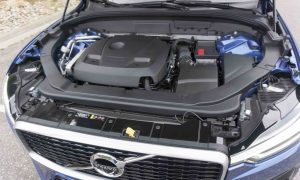
The first version is pretty par for the course: It’s a 2.0 liter four, with a turbo – and 250 horsepower. This is almost exactly the same readout you’ll find across the street at the BMW store. The X3, an XC60 rival, comes standard with a . . . 2.0 liter turbo’d four that makes 248 hp.
Down the Road – at the Audi store – there’s the Q5, which comes standard with a . . 2.0 liter turbo four making 252 hp.
Two-point-oh liter engines with turbos abound.
But how about a 2.0 four with a turbo and a supercharger? That’s the XC60’s next-up engine. And it’s the only such engine currently on the market.
Why both a turbo and supercharger? Why not a pair of turbos – the more common practice?
In a word – lag.
The idea being to completely eliminate it.
Both turbos and superchargers do the same thing – boost engine output by pressurizing the incoming air and forcing it into the engine’s cylinders – but they do it differently.
A turbocharger is driven by exhaust gasses – very much like a water wheel is turned by the water flowing over it. You may already see the issue. Pressure (boost) takes a moment to build because it takes a moment for the exhaust gasses that turn the “water wheel” (the turbo’s impeller) to build enough force to turn it fast enough to build the boost. The sequence is: Push on the accelerator pedal; engine starts to rev – exhaust pressure begins to build . . . and then, turbo boost.
This only takes a moment – but it is a moment.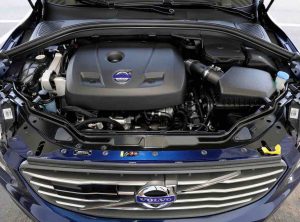
Lag.
It’s been almost dialed out of most modern cars by expedients such as snugging up the turbo as close to the exhaust ports as possible and by using smaller/staged turbos. But that moment of hesitation just before acceleration is still perceptible, especially when you mash the pedal from a dead stop.
Superchargers also build boost, but do so via an engine-driven pulley, which gives immediate boost – no lag. As soon as you push down on the gas pedal, the engine revs and the pulley turns – and you get boost.
The problem with superchargers is that they take a lot of power to drive – more than a turbo, at any rate – which uses “free” spent exhaust gasses rather than the mechanical energy of the engine.
By combining the two, Volvo gets rid of the momentary off-the-line lag which often afflicts turbo-only engines – without the parasitic drag of the blower (as superchargers are sometimes called).
There’s also more power: The double-boosted 2.0 engine makes 316 horsepower and 295 ft.-lbs. of torque .
But maybe that’s not enough.
If it isn’t, Volvo offers the 2.0 engine in one more configuration – a turbo-hybrid configuration. A 46 horse electric motor and 10.4 kWh lithium-ion battery pack boosts the total output of this combo to a triple-espresso 400 horsepower and 472 ft.-lbs. of torque.
So equipped, this version of the XC60 gets to 60 in 4.8 seconds – scalding speed, equaled only by a few ultra-performance sort-of rivals such as the Porsche Macan Turbo – which is a sort-of rival because of its $87,700 to start base price, which is a scalding-to-your-wallet $34,8000 higher than the plug-in Volvo’s starting MSRP. 
It can also go about 18 miles on battery power alone – which the Macan Turbo can’t
This version of the XC60 comes with AWD standard, as is also the case with the turbo-supercharged engine in T6 XC60’s.
One thing that is the same, regardless of engine (or FWD/AWD) is the standard eight-speed automatic transmission and creek/snow day-friendly 8.5 inches of ground clearance.
Crossover SUVs are among the most homogenous of vehicles – in part because of their do-it-all mission. They are family cars that also serve as commuter cars and weekend project/snow-day utility cars.
This makes it hard to infuse them with any dramatic personality differences.
How do you make an exciting egg carton?
Well, you get to work under the hood.
The 2.0 turbo engine is homogenous. It moves the XC60 very much in the same way that the BMW X3’s 2.0 turbo engine moves it. And the Audi Q5’s turbo 2.0, too.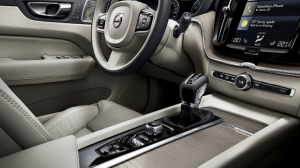
Expect 0-60 in just over 7 seconds and 22 city, 29 highway.
Nothing unusual, certainly.
It’s the engine for the buyer who doesn’t particularly care all that much about what’s under the hood, so long as the rest of the vehicle is a Volvo.
For something not-homogenized, try the turbo-supercharged version of the 2.0 engine. It’s not just the additional 66 horsepower power; it’s the way that power is served up. Like a heavyweight boxer landing a brutal right cross – followed up by a brutal left hook. Things happen fast – and authoritatively.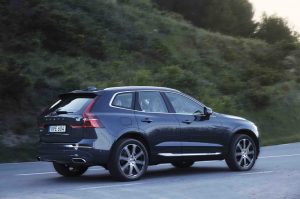
Zero to 60 in about six seconds – with only a slight MPG penalty: 19 city, 27 highway.
The only thing missing is the banshee keening of the supercharger, which has been muffled because this is a Volvo, after all – not Mad Max’s V8 Interceptor.
There’s a slight, detectable whistle from the turbo, though – which was nice of Volvo not to totally silence. If you’ve got guns, there’s nothing wrong with wearing a slightly tight T shirt.
Speaking of guns . . .
The turbo-hybrid XC60 is the kind of fun you’re not supposed to have in a Volvo. It is like a midnight Rave at the Vatican. You enter the place in your robes, head bowed and hands clasped, quietly shuffling.
But once down the basement stairs, those robes come off – and it’s time to party!
Some will buy it because of its green-sleeves appeal.
Like other plug-ins, it’s capable of part-time electric car operation. With a full charge and easy on the accelerator, you can trundle along silently for about 20 miles without burning a drop of gas. This is cool enough in its own right; you can “refuel” at home – or at work – just like a full-time electric car.
But unlike your neighbor’s Tesla, you’re not tied to an electric umbilical cord. If the battery charge runs low, you don’t have to stop to recharge – so long as the tank has gas.
And this thing really hauls ass.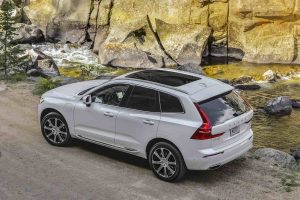
The electric motor serves the same effective purpose as the supercharger – supplying a dose of immediate thrust, so there is no lag.
But it supplies much more thrust – an irresistible tsunami of torque, almost 500 ft.-lbs. of it – the kind of torque made by really big V8s.
And its free chiropractic spinal column adjustment on call.
Floor it and feel your vertebrae realigning. Snap, crackle – pop! Then turn on the massagers for the final smoothing out.
It is a spectacular ride – made even more so because this is a Volvo – and Volvos are not supposed to terrify Porsches.
This one does.
The XC60 is different here, too – even though it doesn’t really look that much different from the crossovers it competes with.
It has some styling touches – such as the centered-slit LED headlights and the Volvo tall-stacked rear brake/tail-lights, which curve backward as the rise toward the roofline.
But it’s size – vs. space – that’s meaningfully different.
The XC60 is 184.6 inches long overall – which makes it just slightly larger overall than the current Audi Q5 (183.6 inches) and just slightly shorter overall than the current BMW X3 (186.1 inches).
It fits in most of the same parking places as its rivals – but people fit more comfortably inside – and you can fit more stuff inside, too.
The XC60 has class-best backseat legroom (38 inches, significantly more than the physically larger BMW, which only has 36.4 inches of backseat legroom) and 63.3 cubic feet of total cargo capacity – which is more than both the Q5 (60.4 cubic feet) and the X3 (62.7 cubic feet).
But there’s a catch – if you’re much taller than average.
All trims come standard with a full-length panorama sunroof, which is an optional feature in most rivals.
The oversized glass panel opens up the car’s interior visually and makes it seem even more spacious – in the same way that big skylights in a modern house do. The downside is that sunroofs eat up headroom and thus, the XC60’s got about two inches less of it for the driver and front seat passenger (38 inches vs. 40 inches in the X3 and 40.2 inches in the Q5).
It’s about the same vs. rivals in the second row, though (38 inches vs. 38.5 in the BMW and 37.7 in the Audi) and I found the front seat to be roomy enough for my six-foot-three self. Still, torsos vary – so you’ll want to sit in the XC60 vs. its rivals and see for yourself.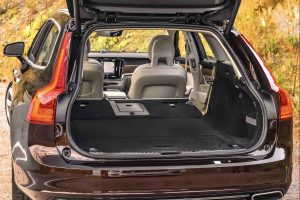
The optional 12.3 inch LCD touchscreen is another point of departure. It is both elegant and functionally superb, in part because of its larger-than-most size – which makes it easier to accurately tap/swipe/pinch through the various menus while the XC60 is moving.
And even if you don’t buy the optional massaging seats – which are worth every dime – Volvo’s seats are exceptionally comfortable regardless.
Few – if any – cars have more comfortable seats. You may not believe it at first, but after six hours in one, you will.
THE REST
The optional air-adjustable suspension smooths out the XC’s fairly firm ride, especially the higher-trim versions with the optional 19 and 20 inch wheels, which come with more aggressive (short sidewall) sport tires.
Volvo offers another thing that’s different here as well: You can adjust the ride height from the rear. There’s a switch in the tailgate, which you can use to lower the XC so as to make it easier to load things into the cargo area.
Volvo also offers what’s called Level 2 autonomous driving – also rare in this class. Level 2 means the car is capable of driving itself . . . kind of/sort of. When engaged, the system will maintain the car’s speed and keep itself in its lane – up to a point.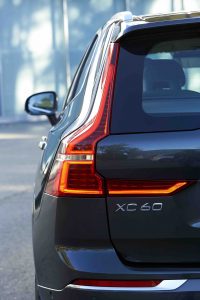
The Catch 22 with these “autonomous” systems is they’re not, really.
The driver is still expected to maintain full time and attention – and be ready to take over if necessary. But that arguably defeats the point of having “autonomous” capability and also arguably encourages the driver to not maintain full-time and attention to driving . . . and then faults him if something goes wrong.
Best to just pay full time and attention.
THE BOTTOM LINE
The lights almost went out at Volvo – because Volvo was still trying to sell what everyone else was selling.
Now Volvo’s got something else to sell – and it’s selling!
. . .
Got a question about cars – or anything else? Click on the “ask Eric” link and send ’em in!
If you like what you’ve found here please consider supporting EPautos.
We depend on you to keep the wheels turning!
Our donate button is here.
If you prefer not to use PayPal, our mailing address is:
EPautos
721 Hummingbird Lane SE
Copper Hill, VA 24079
PS: Get an EPautos magnet (pictured below) in return for a $20 or more one-time donation or a $5 or more monthly recurring donation. (Please be sure to tell us you want a sticker – and also, provide an address, so we know where to mail the thing!)
My latest eBook is also available for your favorite price – free! Click here. 


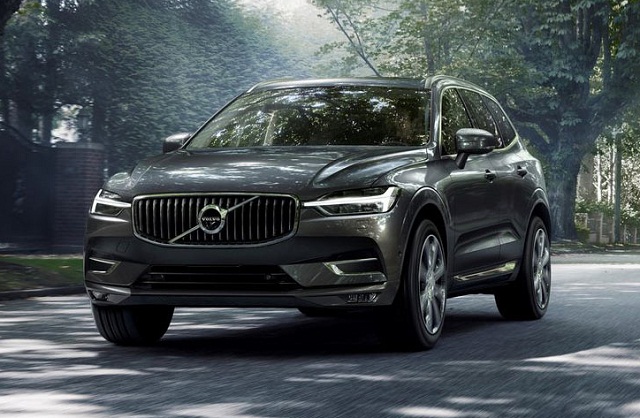

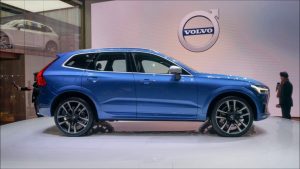
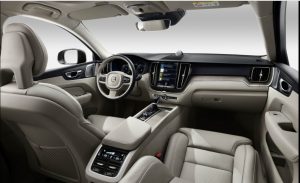
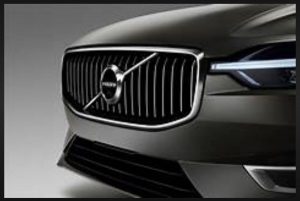
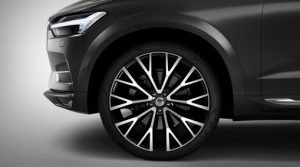
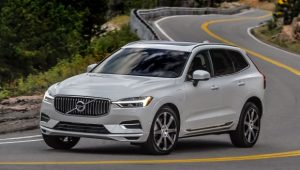
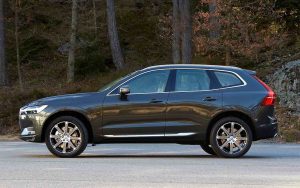







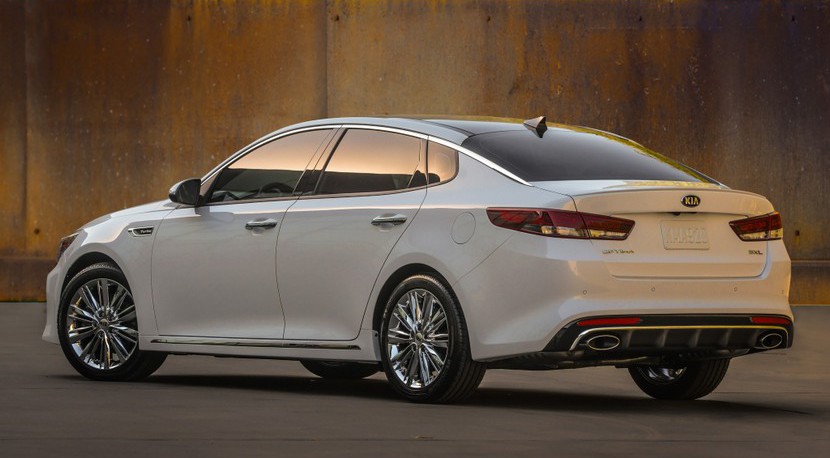
Where’s the Diesels for North American markets? They prove to be the most efficient when one takes into account the entire circle of; energy extraction/production, vehicle mileage(MPG), refueling frequencies, bio diesel fuels efficiencies over the ethanol corp. welfare/tax boondoggle, lost time, long life reliability of diesel engines, maintenance costs, and last but not least, taxes/fees.
e.g. I think the new Volvo xc-40 diesels are rated at 50+ MPG highway and around 37MPG combined, with low CO2 and very low NOx readings.
To conserve fuel and travel costs further, it would be nice if Volvo incorporated something like BMW’s Stop & Go feature. This is becoming more influential feature, especially for metro areas that have turned interstate highways and beltways into parking lots during commuter hours.
The one thing I don’t like about all these auto manufacturers, when you upgrade the engine, the pricing becomes a ridiculous increase, especially for a diesel. I had an uncle that worked for GM his entire career/life (management) and he always joked about paying big increases for upgraded engines. He said once after I showed him the sticker of my new special ordered upgraded V8 Ford, ” Did they put the original V-6 in the trunk… lol? He said engine upgrades are one of the money makers for auto manufacturers.
Release the Volvo Diesels to North America and give us more choices ordering/production of vehicles.
Was it Volvo who came up with the cruise control that would set itself to the PSL automagically? Did this vehicle come equipped with it?
I always liked the “hiking boot” looks of the XC70 Cross Country, but it didn’t live up to the promise of an off-road station wagon. And besides, taking a luxury vehicle on single track is a sure sign of stupidity or too much money. Probably both, in the case of Range Rover…
The T8E looks like a really fun car….to lease. With all that eventually costly to maintain/repair mechanical complexity, don’t think I’d want to own one.
At first, the standard equipment, full length, panorama/Bannana-rama sunroof seems like a frivolous waste of interior space. And in the Az desert, we definitely consider them “undesirable.” In a gloomy environment like Sweden though, they are probably lusting for every possible lumen of sunlight, and will gladly sacrifice headroom to get it. But just like all those other available XC engine/trim combos, it really should be optional.
That you can select your powertrain regardless of trim level is a biggie to me (and my wife). Volvo may be worth a look for my wife’s next car. Nice write-up Eric.
And why I’m in a new 300S trim with V8 rwd for $44K’ish, and not the CT6 I wanted, because I couldn’t get the best-at-the-time 3.0TT in anything but their highest trim, If I remember for well over $70K. Didn’t want AWD, to bad, didn’t want sunroof, to bad, etc….. Granted different cars, but I could option out of things I don’t want with the 300, and I love it.
Agreed, Chris – and thanks for the kind words!